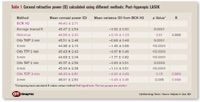Article
Accurate corneal power key to IOL power calculation in post-LASIK eyes
Slit-scanning videokeratography is a useful tool for determining corneal power for IOL power calculation in post-hyperopic LASIK eyes, especially when preoperative refractive information is not available.

Key Points

In the past, several investigators have found that the total power maps created by the slit-scanning videokeratographer (Orbscan IIz Anterior Segment Analysis System, Bausch & Lomb) allow surgeons to calculate accurately the central corneal power following myopic LASIK. Dr. Qazi, clinical instructor, Department of Ophthalmology and Visual Sciences, Washington University School of Medicine, St. Louis, and colleagues published their results in the January issue of the Journal of Cataract and Refractive Surgery (Qazi MA, Cua IY, Roberts CJ, Pepose JS. Determining corneal power using Orbscan II videokeratography for intraocular lens calculation after excimer laser surgery for myopia. J Cataract Refract Surg. 2007;33:21-30).
Corneal power

The investigators used several different methods to calculate corneal refractive power in the post-hyperopic LASIK eyes, including total power maps created by the slit-scanning videokeratographer, average manual keratometry, and historic refraction-based calculations. All of these methods were compared with the back-calculated K values using the Holladay 2 formula via proprietary IOL calculation software (Holladay IOL Consultant, Holladay Consulting).
"The back-calculated K value is based on the patient's actual post-cataract surgery refractive result and therefore reflects the true power of the cornea," Dr. Qazi said.
No statistical difference existed between the back-calculated K values using the Holladay 2 formula and corneal power determined by the historical refraction-based method or the total optical power map at 2-mm central diameter created by the slit-scanning videokeratographer (Table 1).
The results from their previous myopic-LASIK eye study and this hyperopic LASIK eye study were similar in that the total optical power maps seem to describe accurately the power of the cornea. One difference existed, however: the relevant optical zones to be used for corneal power calculation for myopic LASIK are larger than for hyperopic LASIK, he said.
Newsletter
Don’t miss out—get Ophthalmology Times updates on the latest clinical advancements and expert interviews, straight to your inbox.




